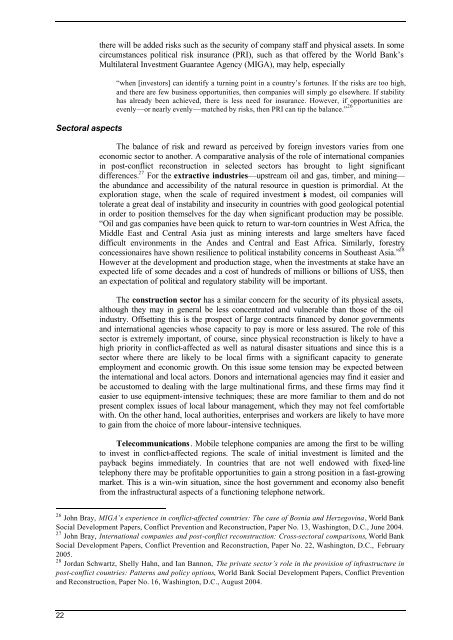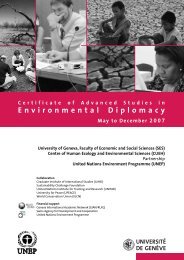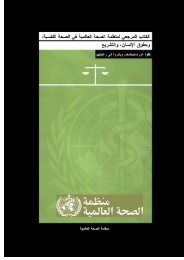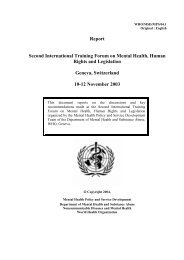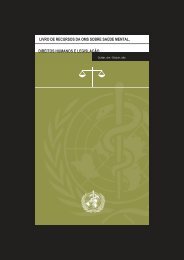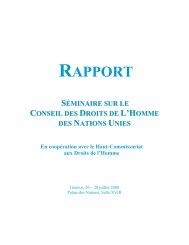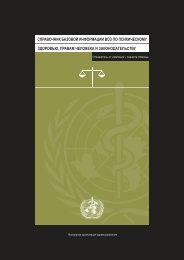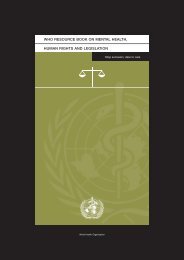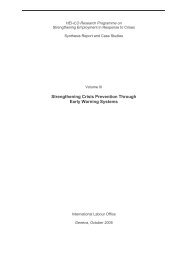Sectoral aspectsthere will be added risks such as the security of company staff and physical assets. In somecircumstances political risk insurance (PRI), such as that offered by the World Bank’sMultilateral Investment Guarantee Agency (MIGA), may help, especially“when [investors] can identify a turning point in a country’s fortunes. If the risks are too high,and there are few business opportunities, then companies will simply go elsewhere. If stabilityhas already been achieved, there is less need for insurance. However, if opportunities areevenly—or nearly evenly—matched by risks, then PRI can tip the balance.” 26The balance of risk and reward as perceived by foreign investors varies from oneeconomic sector to another. A comparative analysis of the role of international companiesin post-conflict reconstruction in selected sectors has brought to light significantdifferences. 27 For the extractive industries—upstream oil and gas, timber, and mining—the abundance and accessibility of the natural resource in question is primordial. At theexploration stage, when the scale of required investment is modest, oil companies willtolerate a great deal of instability and insecurity in countries with good geological potentialin order to position themselves for the day when significant production may be possible.“Oil and gas companies have been quick to return to war-torn countries in West Africa, theMiddle East and Central Asia just as mining interests and large smelters have faceddifficult environments in the Andes and Central and East Africa. Similarly, forestryconcessionaires have shown resilience to political instability concerns in Southeast Asia.” 28However at the development and production stage, when the investments at stake have anexpected life of some decades and a cost of hundreds of millions or billions of US$, thenan expectation of political and regulatory stability will be important.The construction sector has a similar concern for the security of its physical assets,although they may in general be less concentrated and vulnerable than those of the oilindustry. Offsetting this is the prospect of large contracts financed by donor governmentsand international agencies whose capacity to pay is more or less assured. The role of thissector is extremely important, of course, since physical reconstruction is likely to have ahigh priority in conflict-affected as well as natural disaster situations and since this is asector where there are likely to be local firms with a significant capacity to generateemployment and economic growth. On this issue some tension may be expected betweenthe international and local actors. Donors and international agencies may find it easier andbe accustomed to dealing with the large multinational firms, and these firms may find iteasier to use equipment-intensive techniques; these are more familiar to them and do notpresent complex issues of local labour management, which they may not feel comfortablewith. On the other hand, local authorities, enterprises and workers are likely to have moreto gain from the choice of more labour-intensive techniques.Telecommunications. Mobile telephone companies are among the first to be willingto invest in conflict-affected regions. The scale of initial investment is limited and thepayback begins immediately. In countries that are not well endowed with fixed-linetelephony there may be profitable opportunities to gain a strong position in a fast-growingmarket. This is a win-win situation, since the host government and economy also benefitfrom the infrastructural aspects of a functioning telephone network.26 John Bray, MIGA’s experience in conflict-affected countries: The case of Bosnia and Herzegovina, World BankSocial Development Papers, Conflict Prevention and Reconstruction, Paper No. 13, Washington, D.C., June 2004.27 John Bray, International companies and post-conflict reconstruction: Cross-sectoral comparisons, World BankSocial Development Papers, Conflict Prevention and Reconstruction, Paper No. 22, Washington, D.C., February2005.28 Jordan Schwartz, Shelly Hahn, and Ian Bannon, The private sector’s role in the provision of infrastructure inpost-conflict countries: Patterns and policy options, World Bank Social Development Papers, Conflict Preventionand Reconstruction, Paper No. 16, Washington, D.C., August 2004.22
Commercial banking has an important role to play in conflict-affected areas becauseof its role in facilitating a resumption or continuation of normal economic life. Given therisk-averse nature of bankers, and the special security concerns that affect this sector,international commercial banks cannot in general be expected to be the first outsideinvestors to enter a post-conflict environment. However, some regional banks see nicheopportunities in countries where their larger competitors may not wish to go. Examplesinclude Standard Chartered in Africa and Asia, several Austrian banks in Bosnia -Herzegovina, ANZ which became the first foreign bank to open a branch in Timor-Lestefollowing its independence, or Stanbic Bank from South Africa, which operates in 17countries in sub-Saharan Africa. Bray and colleagues go on to note that:Banks’ commercial expansion in post-conflict economies typically follows a sequence.Initially, as with ANZ in Timor-Leste and Standard Chartered in Afghanistan, they may earnmost of their income from international money transfers on behalf of diplomats and aidagencies. Then, as the economy starts to recover, they begin to work on import deals, forexample of reconstruction equipment for large international companies with recognizedcredentials. Later on, they may extend their services to high-net-worth individuals, forexample successful members of an international diaspora who want to invest in their homecountry. Then come infrastructure finance and loans to small and medium enterprises (SMEs).Retail banking tends to come last…[although it] is a desirable long-term objective for bankswho wish to establish a long-term presence in the host country. 29There have recently been indications, as referred to in the preceding section, thatcommercial banks’ traditional reluctance to lend to SMEs in poor countries may bechanging. The rates of return are high, the lending is less vulnerable to economicdownturns than corporate finance, and new technologies for cheap point-of-sale machineshave brought down transaction costs. One study gave examples of corporate activities inSME finance from 18 countries. Citigroup is reported to be examining the potential forlending through the intermediary of micro-finance institutions to small entrepreneurswhom commercial banks would not consider creditworthy as direct clients. 30 The ShellFoundation has a pilot project that aims to provide financing to large numbers of smallenterprises in Africa, to “help bridge the gap between the millions of small-scale Africanentrepreneurs who already understand risk and return and the hundreds of millions of US$in the accounts of risk-averse local banks.” 31 A feature of this programme is that thefinancing is accompanied by mentoring, as experience has shown that often what SMEmanagers perceive to be financial problems are, in fact, basically management problems. Itis also the experience of the ILO, for example in Croatian LED programmes, that creditprovision is more successful if accompanied by business development services.Infrastructure investments are comparable to those in banking in that they areimportant for facilitating activity throughout the economy. Yet governments tend in thefirst years after conflict to confront a bitter paradox: “they can neither absorb fullyreconstruction aid [i.e. public money from international agencies and government donors]nor can they attract much private investment to infrastructure sectors that could offset thestate’s low absorptive capacity”. 32 The challenge for policy is, first, how to provideessential services--during the interim until stability returns for a sufficiently long period formajor investments to again be forthcoming (some six years on average)--and, second, howto accelerate the arrival of the major investments. On the former point, small-scale privateproviders of electricity and water supply do commonly emerge in conflict-affectedcountries, and play a critical role, even if there are irregularities in service and occasional29 Ibid., p. 32.30 Financial Times, Special Report on Business and Development, 14 September 2005.31 Kurt Hoffman, “Lack of investment is the real tragedy in Africa”, Financial Times, 10 June 2005.32 Jordan Schwartz, Shelly Hahn, and Ian Bannon, The private sector’s role in the provision of infrastructure inpost-conflict countries: Patterns and policy options, World Bank Social Development Papers, Conflict Preventionand Reconstruction, Paper No. 16, Washington, D.C., August 2004.23
- Page 1 and 2: HEI-ILO Research Programme onStreng
- Page 3: PrefaceThis three-volume series res
- Page 7 and 8: Table of contentsPreface...........
- Page 9: The Private Sector and Social Partn
- Page 13: Executive summaryPrivate enterprise
- Page 16 and 17: IGOs, NGOs—tend to exclude, or at
- Page 18 and 19: • The World Bank has created a kn
- Page 20 and 21: 2. Private enterprises in conflict-
- Page 22 and 23: Figure 1: The Private Sector Employ
- Page 24 and 25: 2.3. Case study: Promoting multi-et
- Page 26 and 27: downstream, i.e. refining and distr
- Page 28 and 29: Box 1: How does Somalia’s private
- Page 32 and 33: inequities in pricing. “Of the 16
- Page 34 and 35: into the armies are thereby also at
- Page 36 and 37: 3. Private enterprises and social p
- Page 38 and 39: Two natural disasters which have be
- Page 40 and 41: Box 4: Cooperatives in crisis respo
- Page 42 and 43: partners, the tripartite cooperatio
- Page 44: 36forces and that are able to perfo
- Page 48: AcknowledgmentsThe authors of this
- Page 51 and 52: 6.2. Delimiters of women’s econom
- Page 54 and 55: Executive summaryDespite the rich n
- Page 56 and 57: 1. IntroductionSince 1979, under th
- Page 58 and 59: 2. Country profileThe Republic of I
- Page 60 and 61: • activities related to reconstru
- Page 62 and 63: for university education concerning
- Page 64 and 65: 2.4. Economic environment assessmen
- Page 66 and 67: Unemployment (15 years of age and a
- Page 68 and 69: 2.5. PerspectivesDespite devastatio
- Page 70 and 71: 3. The rationale of SME sector deve
- Page 72 and 73: 4. Iraq's SME sector: A profile4.1.
- Page 74 and 75: The Private sector employment pyram
- Page 76 and 77: Table 8: Estimates of total formal
- Page 78 and 79: Feasibility study: almost all respo
- Page 80 and 81:
Table 9: Percentage of female entre
- Page 82 and 83:
Factors for public sector preferenc
- Page 84 and 85:
The recessionary indication of busi
- Page 86 and 87:
Special investment legislation and
- Page 88 and 89:
8. Small entrepreneurs in Iraq: Sto
- Page 90 and 91:
a reasonable income and independenc
- Page 92 and 93:
9. RecommendationsSME-development s
- Page 94 and 95:
Longer-term SME developmentBesides
- Page 96 and 97:
• literature and artistic service
- Page 98 and 99:
2. List of interviews with governme
- Page 100 and 101:
11. Why did you decide establishing
- Page 102 and 103:
33. What are the cost components of
- Page 104 and 105:
59. Are you working on a project, o
- Page 106:
Promoting multi-ethnic stakeholder
- Page 109 and 110:
101
- Page 111 and 112:
103
- Page 113 and 114:
105
- Page 115 and 116:
107
- Page 117 and 118:
109
- Page 119 and 120:
Research methodologyThe research te
- Page 121 and 122:
possibility of conflict. In 1992, a
- Page 123 and 124:
2.2.2. PovertyAfter the break-up of
- Page 125 and 126:
of almost 10 per cent of GDP, yet i
- Page 127 and 128:
Source of initial financing: privat
- Page 129 and 130:
‘It is important to point out tha
- Page 131 and 132:
4.2. The economic resilience of int
- Page 133 and 134:
medium-sized companies employing 24
- Page 135 and 136:
5.2. Addressing constraints for SME
- Page 137 and 138:
5.4. Support to local initiativesSM
- Page 139 and 140:
ConclusionConsidering the actual an
- Page 141 and 142:
Scott, Norman: Macedonia: A Brief E
- Page 143 and 144:
Official gross reserves 4 290 450 7
- Page 145 and 146:
4. Survey questionnaire1. Name of t
- Page 147 and 148:
139
- Page 149 and 150:
141
- Page 151 and 152:
143
- Page 153 and 154:
2. Le contexte2.1. Le paradoxe ango
- Page 155 and 156:
Composition et description des Futu
- Page 157 and 158:
Les généraux angolais sont prése
- Page 159 and 160:
Les syndicats officielsL’Union na
- Page 161 and 162:
Une étude réalisée en 2003 pour
- Page 163 and 164:
3.3. Sortir du cercle vicieux : vie
- Page 165 and 166:
Annexes1. Morceaux choisis : le «
- Page 167 and 168:
159
- Page 169 and 170:
L’implication des partenaires soc
- Page 171 and 172:
Table des matièresTable des matiè
- Page 173 and 174:
RemerciementsQu’il me soit permis
- Page 175 and 176:
Liste des acronymesAFASPAALEANEAANS
- Page 177 and 178:
GlossaireAide d’urgence :Aléa :A
- Page 179 and 180:
Résumé exécutifAu cours des dix
- Page 181 and 182:
1. IntroductionLe département de R
- Page 183 and 184:
Limites de l’étudeAvant de proc
- Page 185 and 186:
évalué à plus de deux milliards
- Page 187 and 188:
2.2.2. Aspects démographiquesLes p
- Page 189 and 190:
2.3.3. EducationDès l’indépenda
- Page 191 and 192:
création de fonds de stabilisation
- Page 193 and 194:
3. Analyse des formes de réponse :
- Page 195 and 196:
• le secteur de l’Eau sera dest
- Page 197 and 198:
• la révision de la législation
- Page 199 and 200:
de main-d’œuvre, encourageant la
- Page 201 and 202:
leur fournissait les équipements e
- Page 203 and 204:
matérielle sous des formes diverse
- Page 205 and 206:
centre de l’attention des partena
- Page 207 and 208:
• le rôle dévolu à la commissi
- Page 209 and 210:
Renforcer le rôle de solidarité d
- Page 211 and 212:
ConclusionLa dimension de la tache
- Page 213 and 214:
Equipe Multidisciplinaire pour l’
- Page 215 and 216:
2. Séries statistiquesTable 8 : Ev
- Page 217 and 218:
Table 11 : Répartition de la popul
- Page 219 and 220:
Table 2 : Liste détaillée des com
- Page 221 and 222:
Table 4 : Dispositif d’interventi
- Page 223 and 224:
Organisation de l’unité syndical
- Page 225 and 226:
- Centre technique de construction.
- Page 227:
219


